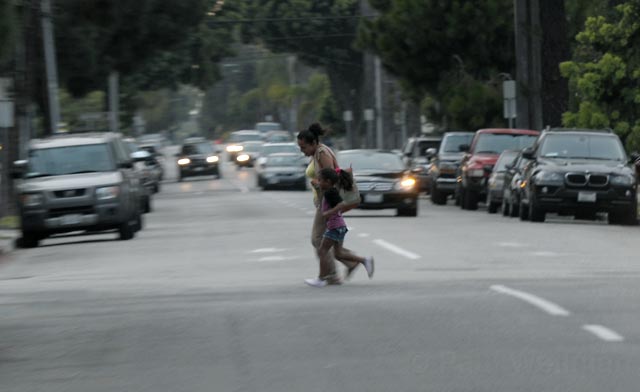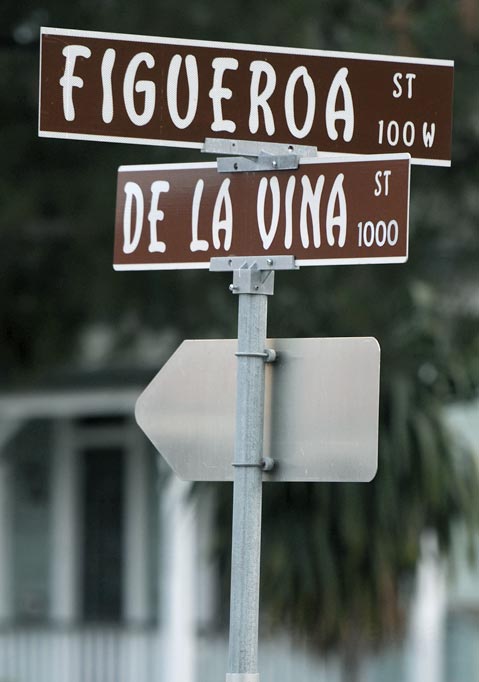De la Vina-Figueroa Won’t Be Safer Soon
City Council Wants More Options on the Table Rather than Four New Bulb-Outs

On Tuesday afternoon during a hearing that took more than two hours, the Santa Barbara City Council was presented with a project that traffic experts from both City Hall and the federal government believe would make one of the region’s most dangerous corners safer by extending the curbs, adding crosswalks, and installing lights to the De la Vina and Figueroa intersection, where one man was killed and another 11 serious accidents occurred between 2007 and 2009. But due to the controversy surrounding such “bulb-outs” — those curb extensions throughout town that have attracted the ire of many car drivers, some bicyclists, and at least half of the city council — the council instead asked the staff to return with a menu of options for the intersection, ranging from the full project to a more basic remedy of crosswalks and lighting.
“The fact that we got a grant for this intersection shows there is a problem they feel we need to address,” explained Browning Allen, the city’s transportation manager, in describing the proposal that could be paid for with a use-it-or-lose-it $326,923 federal grant. He and the hired consultant, Greg Knudson of MNS Engineers, explained that the project would make pedestrians more visible and reduce the amount of street to cross by 30 percent. Neighbors also spoke in favor of bulb-outs, with one man calling it a “scary intersection” in the middle of “stroller, dog-walking central.”
But their advocacy ran into the anti-bulb-out politics led by the council’s pro-car pragmatist Michael Self, who played a homemade video and slide show about the anecdotal dangers that bulb-outs and other traffic calming devices pose to automobiles. “Beware of safety improvements,” she warned, with councilmembers Frank Hotchkiss (who prefers the term “bottlenecks”), Dale Francisco (who argued for a simpler and less expensive solution), and Randy Rowse (who called himself an “agnostic on bulb-outs”) seeming to agree.

Mayor Helene Schneider (who called Self’s multimedia show “dramatic but simplistic,” noting that each intersection cited was unlike the De la Vina-Figueroa situation) and Councilmember Grant House appeared to support the staff’s recommendation, but knew they were outnumbered. (Councilmember Bendy White, who’s voted against bulb-outs in the past, was absent.) So House took what Rowse was saying and turned it into a motion that requested staff to come back with changes. That passed 4-2, with Self and Hotchkiss against it, as they would have preferred to handle the matter for good then and there (which would effectively have led to returning the grant, given that it was an all-or-nothing option).
Unfortunately for many who’ve requested changes at the intersection for years, the afternoon also brought news that a traffic signal at the intersection is not warranted by federal standards, meaning that it’s unlikely the cash-strapped city would be able to pay for a light there anytime soon. The good extra news, however, was that MTD’s buses have stopped using the intersection in favor of Anapamu Street — which was reported to be a beneficial solution for all — and there have not been any significant wrecks in the area over the past two years.
That doesn’t mean residents feel any safer, though. (Full disclosure: The Santa Barbara Independent offices are located on this block, so many staff members — including this writer, who alternately drives, rides a bike, and walks to work — have risked life and limb to cross this frequent near-miss intersection.) “We would really like to see some safety improvements … they’re necessary,” said Brittany Heaton, who lives on West Figueroa Street with her family, including her baby named Stella who was strapped to her chest during public comment period. “If I’m not paying attention … I’m going to get plowed down.”
Representing the city’s Transportation and Circulation Committee was Keith Coffman-Grey, who also happens to walk through the neighborhood on a regular basis. He’s witnessed the aftermath of three accidents in recent years, including the fatality, and says he was nearly run over himself while walking on the south side of the De la Vina crossing, where cars coming off of Figueroa Street often turn left without looking for pedestrians because the drivers are so worried about oncoming traffic up the street. Knowing that bulb-outs are a political hot potato, Coffman-Grey suggested the possible compromise of just bulb-outs on the east side of Figueroa, where people — including elderly residents of Garden Court — often walk to Ralphs grocery store and the northside of De la Vina, with signs that block or at least discourage pedestrians crossing the southside of De la Vina.
Longtime progressive gadfly Lee Moldaver was openly critical of the council for trading expert-supported public safety for populist politics. “All you have to do is say yes and make it safer,” said Moldaver. He was followed by a couple of speakers who were hostile to bulb-outs, claiming that they were stupid, ugly, and contrary to liberty.
At the end of the hearing, those latter sentiments could claim at least some victory, for the bulb-outs aren’t coming to De la Vina and Figueroa streets anytime soon. For the residents and workers who must brave the intersection every day, there’s at least hope that something will come to someday in the future, even if it’s just a crosswalk.



